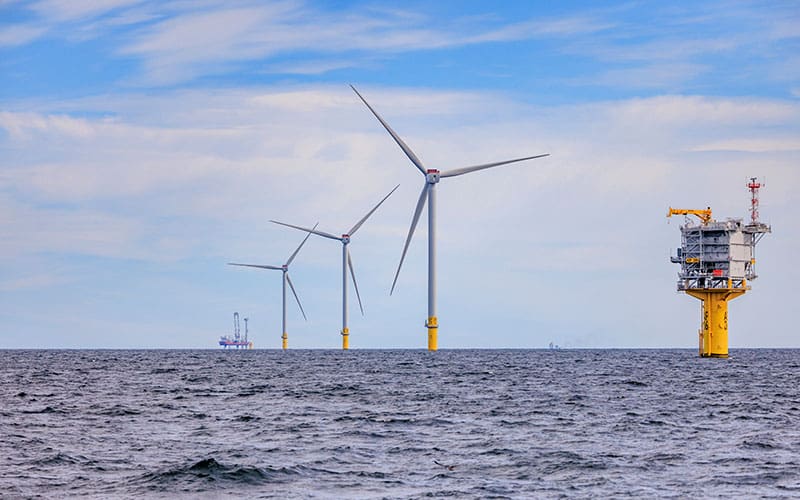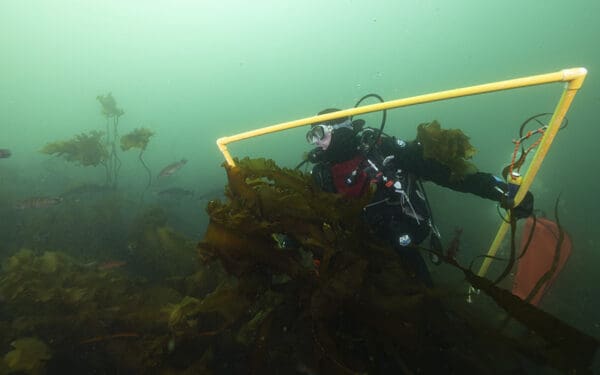
South Fork wind turbines off the coast of Rhode Island. Photo: EcoPhotography
Balancing renewable offshore wind energy with protecting the wild spaces and delicate marine life of the ocean is possible and necessary – but it’s not always easy. That’s why CLF, alongside other environmental advocacy organizations, advocated for the South Fork Wind project, off the coast of Rhode Island, to adopt robust measures to reduce impacts to the seabed habitat in the vicinity of the project.
The developers recently published the initial results of their seabed monitoring study, and while there’s still lots of information to collect and analyze, the early information on the project’s impact on the seabed is very encouraging. Researchers have not detected demonstrable changes in the seabed ecosystem, which represents tremendous promise for the likely impacts from offshore wind farms.
An Offshore Wind Project Has Created New Habitat for Marine Life
Offshore wind farms are designed to minimize impacts to the seafloor. In fact, the only parts of the South Fork Wind project that touch the bottom of the ocean are the 12 turbine’s foundations and the big rock piles that protect them. This takes up just 0.02% of the project’s area. Nonetheless, scientists weren’t sure how these new structures might impact the seabed ecosystem. This early report suggests that the construction has had beneficial impacts by adding new structures to the environment that marine invertebrates attach to and grow on. The new habitat and invertebrate prey have attracted fish and shellfish in what is known as a “reef effect.”
Some sea critters rely on rocky habitats with lots of nooks and crannies for hiding from predators and foraging for food. The infrastructure that keeps offshore wind turbines anchored to the seafloor provides exactly that. Between 2023 and 2024, scientists observed a shift from bare concrete and rocks to “artificial reefs,” glimpsing beloved species like lobster and black sea bass in and around the structures.
Scientist Found Thriving Marine Life on Relocated Boulders
You can’t build anything without disrupting the surrounding environment to some degree, and that’s especially true for anything as substantial as energy infrastructure. For the South Fork Wind project, the construction process included moving some boulders on the seafloor. Since boulders can provide key habitats for marine life, the developers attempted to move as few boulders as possible and minimized the distance that they were removed.
Just a year later, images showed no significant difference in the amount of life supported by relocated and non-relocated boulders. Anemones, sea stars, sea raspberry, northern star coral, and more, all made their home on the shifted boulders. This colorful array of life is as rich and varied as the critters found in and around the boulders that stayed in place. Overall, the project seems to have resulted in limited to no negative impacts on the seafloor.
What’s Next for Offshore Wind Farms in New England?
These results provide an encouraging glimpse into the future of offshore wind projects in New England. Revolution Wind, another offshore wind development owned by the same company, is located in the vicinity of the South Fork Wind project and has similar underwater habitats. It will also use similar, if not identical technology and construction processes. Much of Vineyard Wind, another forthcoming project, will use similar underwater structures in an area that will require even less seafloor disruption. This study indicates that these offshore wind developments could also cause limited negative impacts to the seabed and may even yield some benefits.
While this report is a strong, promising start, there is more work yet to be done. South Fork Wind developers are still looking into other key issues, like the impact of the development on vulnerable Atlantic cod and the effects on marine species of the electromagnetic fields generated by the underwater cables used to transmit the project’s power to shore. CLF has fought for responsible, evidence-based implementation of offshore wind in New England, including comprehensive research at every step. As offshore wind energy continues to expand and provide New Englanders with much-needed renewable energy, we’ll continue to ensure that our ocean is protected as well.



